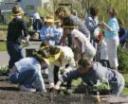 In rural areas where jungles boarder frontier towns, loggers are turned into farmers with help from the UN and other aid agencies who provide education on how their actions such as logging, charcoal making and stripping of forest can spell the end for the lifestyles they wish to protect. Indigenous people are tapped for better understanding of forests which they have hunted and subsisted on for millennia giving them the power to protect the land on which they live on with assistance from environmental groups.
In rural areas where jungles boarder frontier towns, loggers are turned into farmers with help from the UN and other aid agencies who provide education on how their actions such as logging, charcoal making and stripping of forest can spell the end for the lifestyles they wish to protect. Indigenous people are tapped for better understanding of forests which they have hunted and subsisted on for millennia giving them the power to protect the land on which they live on with assistance from environmental groups.
Local cultures are corrected to prevent wiping out species such as sea turtles, birds and other resident animal species to prevent them form extinction. With the case of sea turtles which have high mortality rate from birth to adulthood, they may not have a nesting ground to return to when it is their time to contribute to their dwindling species due to development for tourism and other necessities.
Oil has had resurgence in terms of prices and forecasts of dwindling supplies plus worldwide political tensions have cause much alarm to economists. The need for alternative energy is not an alternative anymore but more of a must if we all want to keep on living on this earth for the rest of our lives.
Much is the power of man to create and destroy what nature has spent millions of years to create. Million of years on evolution have been wiped out in a few short years by over hunting, fishing and development of previously pristine areas that used to teem with wildlife and other native plants. Man needs to protect and recognize the importance of biodiversity if we are to ever continue to live on this planet for we are the only life forms on this earth who are capable of influencing and exacting change in the hearts and minds of all of Mother Nature’s creatures.
Originally posted on March 4, 2008 @ 11:28 pm



 As we all know, awareness about nature is the sort of humane actions that has been helping wildlife all over the world for sometime now. The charities like the;
As we all know, awareness about nature is the sort of humane actions that has been helping wildlife all over the world for sometime now. The charities like the; 





